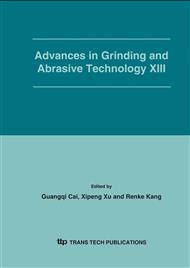p.550
p.555
p.560
p.565
p.570
p.575
p.579
p.584
p.588
Study on Dynamic Strength Model of Contact Layer in Quick-Point Grinding
Abstract:
Ultra-high grinding speed and point contact are the salient natures of Quick-point grinding. Based on the damage dynamics theory, there are impact damages with a lot of micro-cracks and micro-defects and adiabatic shearing caused by ultra-high strain rate in the contact layer in such grinding manner. The micro-damages are relation to the strain rate and the materials properties, and increase with raise of strain rate. Because of the weakening effect of strain rate, the dynamic strength of the contact layer in Quick-point grinding is decreased and the grinding performance of ductile and brittle materials is also changed. The dynamic strength model of the contact layer in Quick-point grinding was built in this paper, and the weakening effects of strain rate caused by impact micro-damages on the dynamic strength of the layer and the materials removal mechanism in grinding layer were analyzed through the study on the theory and the experiments.
Info:
Periodical:
Pages:
570-574
Citation:
Online since:
February 2006
Authors:
Price:
Сopyright:
© 2006 Trans Tech Publications Ltd. All Rights Reserved
Share:
Citation:


